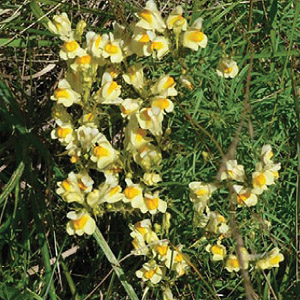Yellow Toadflax
 Linaria vulgaris
Linaria vulgaris
Overview
Brought from Europe over 100 years ago as an ornamental plant, Common Toadflax has escaped and has now become a serious problem to rangeland and mountain meadows all over North America. This perennial plant makes seed, but reproduction is primarily by sprouting from its extensive, creeping root system (rhizomes) - 2-3 week old seedlings can produce creeping roots.
The ability of this plant to form large colonies allows it to crowd out other vegetation.
Common toadflax is easily confused with Leafy Spurge before flowering, but toadflax stems do not contain the milky latex that spurge does. Also known as Yellow Toadflax, Butter-and-Eggs, or Spurred Snapdragon.
Habitat
Native to nearly all parts of Europe and Asia, Toadflax prefers sandy-gravelly soils, but is adapted to a wide range of growing conditions.
 Identification
Identification
Stems: Stems are erect, hairless, generally un-branched and can be as short as 15cm or grow to 1 mtall. Mature plants may have 1 to 25 stems.
Leaves: Leaves are soft, lance shaped,pale green, and very numerous. Leaves are mainly alternate but may appear opposite on the lower stem due to crowding. Leaves can be up to 10 cm long and are attached directly to the stem.
Flowers: Flowers are bright yellow, arranged alternately in dense spikes at the ends of stems and have a long spur extending from the base that is usually as long as the flower itself - in all, 2 to 3.5 cm long. The Snapdragon-like flowers can have orange colouring on the throat. They flower at different times depending on site conditions.
In high elevations they could flower as late as July. Flowers are identical to Dalmatian Toadflax, but leaf shape differs between the two plants.
Seed: The seeds are winged, disk-shaped, and dark brown to black. Despite its prolific seed production (5000 seeds/stem) and long viability (up to 10 years), germination rates are often very low - less than 10%.
Prevention
Spurred Snapdragon, another common name for this plant, often appears in wildflower seed mixes. Do not purchase seed mixes which don't list their contents.
Information and photo provided courtesy of the Alberta Invasive Plants Council.
Resources
Yellow Toadflax ISCM Fact Sheet
2011 Rural Municipality Distribution Map
2010 Rural Municipality Distribution Map
Â
Yellow Toadflax MWSAÂ 2009 Survey Map
Alberta Invasive Plant Council Fact Sheet
Back to Terrestrial Invasive Species List
Â
© Copyright 2004-2025 - CMS Made Simple
This site is powered by CMS Made Simple version 1.4.1


